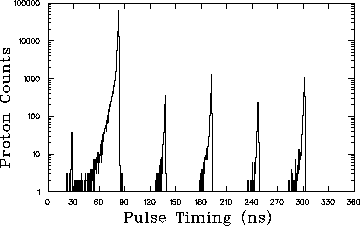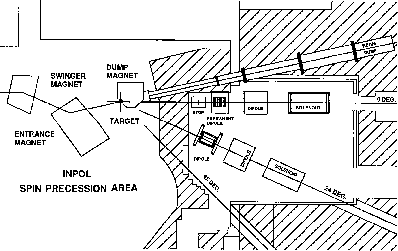The swinger consists of two large dipole magnets, labelled entrance magnet
and swinger magnet in figure ![]() . In a time-of-flight experiment
of the sort that was carried out here the detector is necessarily confined
to a single point at the end of a long flight path. This means that it is
not possible, or at least extremely inconvenient, to move the detector to
measure observables at different scattering angles. Instead the entrance
and swinger magnets bend the proton beam so that it is incident on the
target from a different angle, as shown in figure
. In a time-of-flight experiment
of the sort that was carried out here the detector is necessarily confined
to a single point at the end of a long flight path. This means that it is
not possible, or at least extremely inconvenient, to move the detector to
measure observables at different scattering angles. Instead the entrance
and swinger magnets bend the proton beam so that it is incident on the
target from a different angle, as shown in figure ![]() .
.

Figure: Schematic view of the proton path through the beam swinger
[Hua91].
This effectively changes the scattering
angle and, therefore, the momentum transfer at which measurements are being
made. The combination of the two magnets can swing the beam to any angle
between  and
and  . Figure
. Figure ![]() also shows that
there are two flight paths away from the target; one at
also shows that
there are two flight paths away from the target; one at  and
one at
and
one at  , both of which were in use during the experiment. This
allows measurements to be taken at two angles simultaneously (separated by
, both of which were in use during the experiment. This
allows measurements to be taken at two angles simultaneously (separated by
 ) out to
) out to  , or a momentum transfer of
, or a momentum transfer of
 . It should be noted that at any angle aside
from
. It should be noted that at any angle aside
from  the polarization of the incoming protons with an in-plane
polarization (
the polarization of the incoming protons with an in-plane
polarization ( or
or  ) will be precessed by the dipole
fields. This extra precession must be compensated for by the BL3 and BL5
precession solenoids.
) will be precessed by the dipole
fields. This extra precession must be compensated for by the BL3 and BL5
precession solenoids.